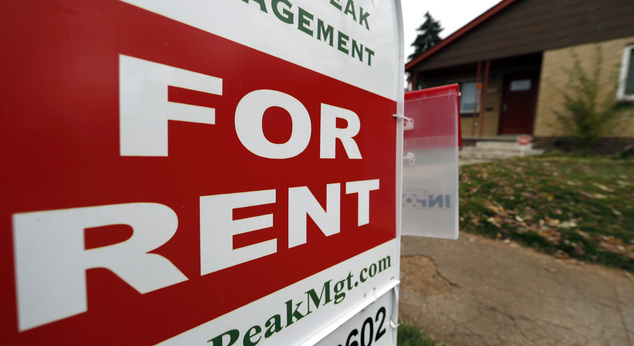More than half of US renters 40 and older, study says
WASHINGTON (AP) — The majority of U.S. renters are now 40 and older, a fundamental shift over the past decade that reflects the lasting damage of the housing crash and an aging population.
This finding in a report released Wednesday by Harvard University's Joint Center for Housing Studies overturns the assumption that the rental boom is only the result of twenty-somethings flocking to hip urban centers. Single-family houses are a growing share of rentals. And affordability problems are mounting as rents rise faster than wages, while apartment construction increasingly targets tenants with six-figure incomes.
Nearly 51 percent of renters have celebrated their 40th birthday, according to the report's analysis of Census Bureau data. That amounts to 22.4 million households.

FILE- In this Nov. 20, 2015, file photo, a rental sign is seen outside a property in Denver. The majority of U.S. renters are now older than 40, a fundamental shift over the past decade that reflects the lasting damage of the housing crash and an aging population, a study said Wednesday, Dec. 9. (AP Photo/David Zalubowski, File)
A decade ago when the housing bubble peaked in 2005, 47 percent of renters — or 16.4 million households — were older than 40. Their share was 43 percent in 1995.
The increase in older renters corresponds with a surge in foreclosures after the housing bubble popped. Since the 2008 financial triggered by the housing bust, there have been roughly 6 million completed foreclosures, according to CoreLogic, a property data firm.
Many of these are former owners who have transitioned to renting.
"Middle-aged households in particular bore a big brunt of the housing crash," said Christopher Herbert, managing director of Harvard's Joint Center for Housing Studies.
But Herbert also noted that more of the baby boomers born after World War II are growing older, which has also caused sharp increases in the number of renters between the ages of 55 and 69 during the past 10 years. During that same period, the United States has added a total of 9 million renters — including younger millennials recent out of college.
But demand has outpaced supply and caused prices to rise.
Rents increased 7 percent between 2001 and 2014 after adjusting for inflation, while incomes fell 9 percent, the report said.
The result is that a larger number of Americans must devote more than 30 percent of their income to rent, a level that the government considers to be financially burdensome. Over the past decade, that number has jumped from 14.8 million to 21.3 million, or 49 percent of all renters.
The share of renters being financially burdened has dropped from their 2011 peak, but their total numbers continue to climb.
Construction has done little to ease the problem. Permitting for multifamily construction has increased a robust 17 percent this year.
But the median rent on a newly built apartment was $1,372 a month in 2014, about $500 more a month than what about half of renters could afford without being financially burdened.
Much of the apartment construction has catered to wealthier households looking to live near restaurants, parks, gyms and offices. The number of rental households earning in excess of $100,000 has risen by 1.6 million in previous decade.
Even people with decent incomes between $30,000 and $44,999 can't keep up with the rent in the wealthiest markets. More than 70 percent of renters at this income level are classified as financially burdened in Washington, DC, San Francisco, Los Angeles, New York City and Miami.
"We've gotten ourselves into a deep hole — and it's not going to be easy to get out of it," Herbert said. "We expect the affordability problem will persist."







































































































































































































